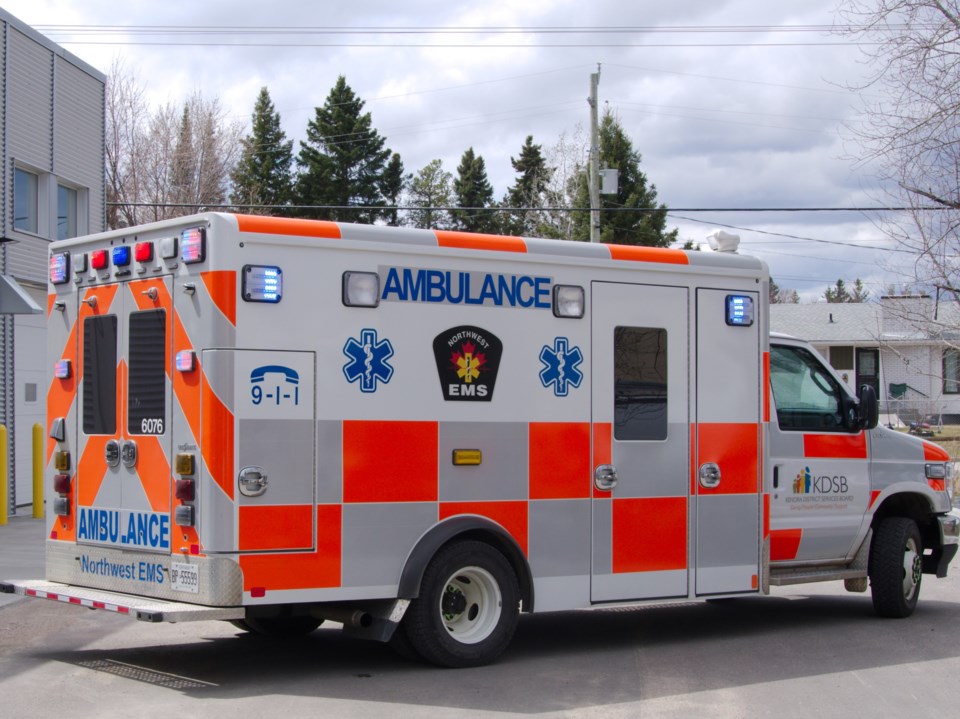KENORA – Better pay would go a long way to solving the region’s shortage of paramedics, says the president of CUPE Local 5911.
“What we’re finding is the main problem … is just that the paramedics are falling behind other classes of emergency services in regards to compensation and pay,” Derek Hamilton, whose union represents Kenora district paramedics, said in an interview this week.
He said paramedics in the Peel Region, part of the Greater Toronto Area, are paid about 30 per cent less than emergency responders in the fire and police services.
“And even ambulance dispatch has gotten a few large raises recently,” he continued.
“So now, basically, when you call for an ambulance, the least paid people that show up are the paramedics, because when you’re looking at nurses, crisis workers, the dispatchers, the police, the fire —they’re all paid more.”
Because of the pay levels, paramedic work is “just not seen as a viable career nowadays” by many, he said. “And that’s causing shortages across the province.”
The pay problem is compounded by the fact paramedics in Northwestern Ontario are paid much less than southern counterparts, he said.
“I mean, in some places in southern Ontario, they’re making almost $12 an hour more than we are here.
“And when the majority of the schools that produce paramedics exist further south, people aren’t looking to come up here.”
David Hamilton, chief of the Kenora District Services Board’s Northwest EMS, says they’ve “definitely pulled out all the stops” to address paramedic recruitment challenges.
He said the board has a robust bursaries program to help high school grads pay for training, and it has “created an education fund for recent graduates who commit to work in the district.
“Once they get on board with us and they put in a full year of work, they get a reimbursement of $4,000. And if they complete another full year … they get an additional 4,000. That supports efforts of recruitment and retention.”
As well, he said, Northwest EMS supports regional college programs in paramedic training. Locally trained paramedics are more likely to stay in the region, he said.
And there’s more.
“We are providing free housing in several communities to support paramedics who are committing to work in our district, in our communities, and we’re providing financial incentives as well to support our very remote (locations) to secure staffing,” he said.
The Municipality of Sioux Lookout is working on a possible agreement with the board “to have our firefighters assist on calls when (a paramedic is working alone), for non-medical interventions like assisting with patient transport,” said Mayor Doug Lawrance.
“It’s a short-term kind of Band-Aid solution, but that’s something we’re doing here as a municipality.”
Normally patient transport to a hospital requires two paramedics — one to drive the vehicle, one to attend to the patient while in transit.
Provincial regulations don’t allow firefighters to be employed as ambulance drivers, Northwest EMS chief Hamilton said.
“However, we do also understand the limitations in our district and some of our communities, and we’ve got very good partnerships with our allied agencies — police and fire.
“And in an emergency, if the paramedic determines that (transport to a hospital) is in the best interest of the patient or that the condition of the patient warrants a stand-in driver such as a police officer or firefighter, the paramedic has the support and the discretion to request a firefighter or police officer to drive.”
Derek Hamilton of the paramedics union said the assistance of firefighters in such situations is appreciated, but there really is no substitute for having two paramedics on the scene supporting each other.
It’s good to have another paramedic around “to confirm and double-check” one’s work, he said. “That’s how we’re trained to do it.”
A longer-term solution would include more local training of paramedics, Lawrance said.
“If people who are more local to the region are trained, there’s a much higher likelihood that they would stay and live and work here.”
Amid the staffing crunch, David Hamilton said, “the paramedics are just fantastic in the way they are stepping up to provide the care that is needed in our district. So, honestly, I think collectively a big thanks is in order for those efforts from the paramedics.”
